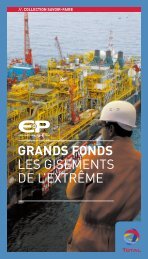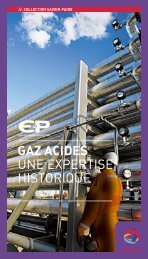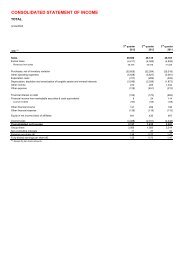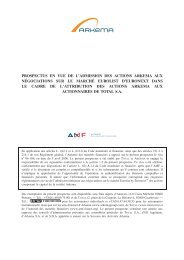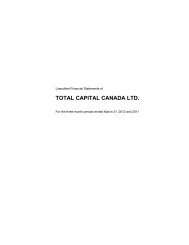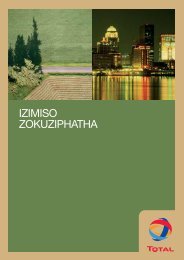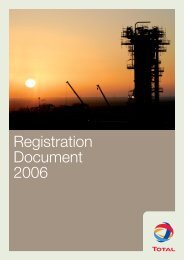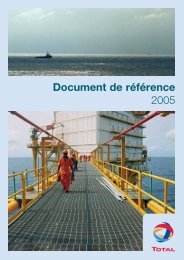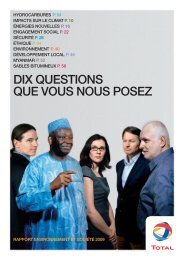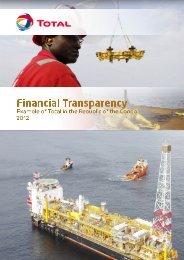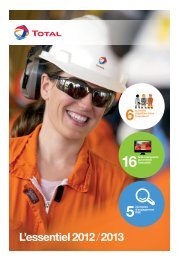Registration Document 2005 - Total.com
Registration Document 2005 - Total.com
Registration Document 2005 - Total.com
You also want an ePaper? Increase the reach of your titles
YUMPU automatically turns print PDFs into web optimized ePapers that Google loves.
9<br />
Non-current debt<br />
Appendix 1 – Consolidated financial statements<br />
Notes to the consolidated financial statements<br />
Changes in non-current debt have been presented as the net<br />
variation to reflect significant changes mainly related to revolving<br />
credit agreements.<br />
S. Business <strong>com</strong>binations<br />
Business <strong>com</strong>binations are recognized using the acquisition<br />
method. This method implies the recognition of the assets, liabilities<br />
and contingent liabilities of the <strong>com</strong>panies acquired by the Group at<br />
their fair value.<br />
The difference between the acquisition cost of the shares and the<br />
total valuation, at fair value, of the assets, liabilities and contingent<br />
liabilities identified on the acquisition date is booked as goodwill.<br />
If the cost of an acquisition is less than the fair value of the<br />
net assets of the subsidiary acquired, an additional analysis is<br />
performed on the identification and valuation of the identifiable<br />
elements of the assets and liabilities. The residual negative goodwill<br />
must be booked directly as net operating in<strong>com</strong>e.<br />
The analysis of goodwill is finalized within one year from the date of<br />
acquisition.<br />
T. Emission rights<br />
In the absence of a current IFRS standard or interpretation on<br />
accounting for emission rights, the following principles have been<br />
applied:<br />
•<br />
•<br />
•<br />
emission quotas issued free of charge are accounted for at zero<br />
book value;<br />
transactions that have been made on the market are recorded at<br />
cost;<br />
the liabilities resulting from potential differences between available<br />
quotas and quotas to be delivered at the end of the <strong>com</strong>pliance<br />
period are accounted for as a liability, at fair market value.<br />
U. Alternative IFRS methods<br />
For measuring and recognizing assets and liabilities, the following<br />
choices left by the IFRS norm among alternative methods have<br />
been made:<br />
•<br />
•<br />
tangible and intangible assets are measured using the historical<br />
cost model instead of the revaluation model;<br />
interest expenses incurred during the construction and acquisition<br />
period of tangible and intangible assets are capitalized, as<br />
provided for under IAS 23 “Borrowing Costs”;<br />
176 TOTAL - <strong>Registration</strong> <strong>Document</strong> <strong>2005</strong><br />
•<br />
actuarial gains and losses on pension and other postemployment<br />
benefit obligations are recognized according to the<br />
corridor method as from January 1, 2004 (see note 1 Q to the<br />
consolidated financial statements);<br />
•<br />
jointly-controlled <strong>com</strong>panies are consolidated using the<br />
proportionate method, as provided for in IAS 31 “Interests in<br />
Joint Ventures”.<br />
V. New accounting principles not yet in effect<br />
The standards or interpretations published respectively by<br />
the International Accounting Standards Board (IASB) and the<br />
International Financial Reporting Interpretations Committee (IFRIC)<br />
which were not yet in effect at December 31, <strong>2005</strong> were as follows:<br />
(i) IFRS 7: Financial instruments: disclosures<br />
In August <strong>2005</strong>, the IASB issued IFRS 7 “Financial Instruments:<br />
Disclosures”. The new standard replaces IAS 30 “Disclosures in<br />
financial statements of Banks and Similar Financial Institutions” and<br />
provides amendments to IAS 32 “Financial Instruments: Disclosure<br />
and Presentation”. IFRS 7 requires disclosure of qualitative and<br />
quantitative information about exposure to risks resulting from<br />
financial instruments. It applies to the annual period beginning on<br />
or after January 1, 2007. The application of IFRS 7 should not<br />
have a material impact for the Group given the disclosures already<br />
presented in the consolidated financial statements for the year<br />
ended December 31, <strong>2005</strong>.<br />
(ii) IAS 19: Employee benefits<br />
In December 2004, the IASB issued limited amendment to<br />
IAS 19 “Employee Benefits”. This revision requires in particular<br />
providing additional information in the notes to the consolidated<br />
financial statements. It applies to annual period beginning on or<br />
after January 1, 2006. The application of IAS 19 should not have<br />
a material effect on the information provided in the notes to the<br />
consolidated financial statements.<br />
(iii) IAS 39: Financial instruments: recognition and measurement<br />
In <strong>2005</strong>, the IASB issued three amendments to IAS 39:<br />
Cash flow hedges for future intra-group transactions<br />
In April <strong>2005</strong>, the IASB issued an amendment to IAS 39 concerning<br />
cash flow hedges for future intra-group transactions. The purpose<br />
of this revision is to allow, in the consolidated financial statements,<br />
the designation of a future intra-group transaction as an item<br />
hedged against the foreign exchange risk in a cash flow hedge<br />
relation, subject to certain conditions.




